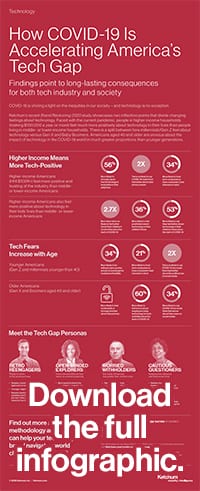Technology was supposed to be the great equalizer, hurdling societal and economic barriers to level the information playing field for all the world’s citizens.
That premise has been in doubt for a while, however. And the global COVID-19 pandemic appears to be exposing ways that technology is deepening, not bridging, our world’s inequity gaps.
The pandemic made us rely on technology more than ever, for working from home, accessing education, socializing, entertainment, shopping and even access to critical healthcare and other resources. For many of us, our worlds contracted to our immediate four walls and a computer screen. Yet behind this increased reliance on technology lies evidence of a growing divide for a variety of audiences.
According to Ketchum’s Brand Reckoning 2020 research study, higher-income citizens—those with annual household incomes of $100,000 or more—are 34% more likely to strongly agree that technology is invaluable in their daily lives than those earning under $100,000.
Further, the higher-income respondents are twice as likely to say COVID-19 made them feel better about data privacy issues; 34% more likely to trust that tech companies have consumers’ best interests in mind; and more than twice as likely to feel better about their children’s screen time since the start of the pandemic.
Age plays a factor, too. Older generations of Americans (Gen X and Boomers) are more likely than younger Americans (Gen Z and Millennials) to be worried about data privacy. They are also more likely, since the start of COVID-19, to feel worse about the possibility of fake news on social media, and that employers are heightening Big Brother fears by using technology to track employees’ work activities.
These revelations are fascinating—albeit troubling—for technology companies and their communicators. In an era when tech is under increasing regulatory scrutiny, the COVID-19-driven disparity in how older and/or less wealthy Americans perceive technology could lead to further societal fragmentation. Where it was once enough to create cutting-edge innovations and unleash them into a world of eager early adopters, the onus is increasingly on the technology industry to define not only which technologies come to market, but how to drive towards more equitable adoption and access.
Once seemingly impervious to scrutiny, tech brands—and their comms teams—increasingly find themselves on the defensive. Much of the criticism from consumers, including a subset of tech-savvy influencers we’ve dubbed Techruptors (based on Ketchum’s annual Social Permission and Technology Study), stems from growing concerns about data privacy and security that many tech companies are unprepared to answer.
Now, layering in the age- and income-based fears some audiences have about technology during COVID-19, tech communicators have even more reputational challenges to prepare for or sidestep. While every company’s situation is different, we have a few suggestions on matters to consider given these recent findings, such as:
 Update your audience understanding. Audience research becomes dated more quickly than ever before. Data points that led your market approach pre-COVID may no longer be valid. Consider more frequent research pulses that allow you to stay close to your audience and course-correct with greater agility. And understand who is driving your reputation.
Update your audience understanding. Audience research becomes dated more quickly than ever before. Data points that led your market approach pre-COVID may no longer be valid. Consider more frequent research pulses that allow you to stay close to your audience and course-correct with greater agility. And understand who is driving your reputation.- Keep an eye on the regulatory climate. Concerns exacerbated by COVID-19 may prompt more governmental entities to further scrutinize your industry—and the upcoming Presidential election will have a significant impact. Stay in lockstep with your government affairs team to get ahead of these issues. And remember the impact of criticism by consumer advocates on government affairs.
- Consider self-regulation. One way to head off unwanted regulatory interference is to take the bull by the horns. Several leading tech providers have instituted an Office of Responsible Use of Technology, which provides a framework for considering the ethical implications of your fast-evolving technology platforms.
- Be transparent. By openly, honestly and clearly conveying your practices around data security, privacy and other issues, you will remove misconceptions and lower customers’ technology angst levels.
- Don’t underestimate technology literacy campaigns. Are you doing your part to bridge the tech gap? It’s not just about donating hardware or services to the underserved. It also means making sure you are providing easy-to-access and -understand education on how to use your technologies. Working with key partners on such campaigns—from non-profits to local governments—can have long-reaching effects on your reputation and global impact.
The world is ever-changing, and COVID-19 has accelerated the process. We’d be happy to help your technology brand navigate the new normal via relevant, on-point communications; visit our Tech Gap landing page for more information, and feel free to reach out.




